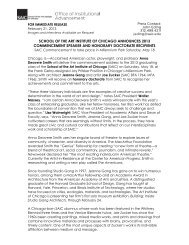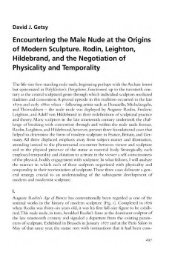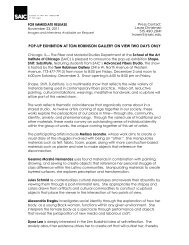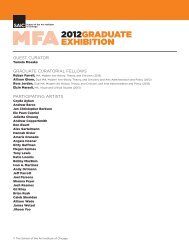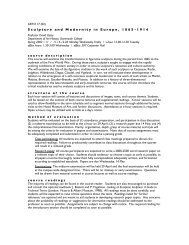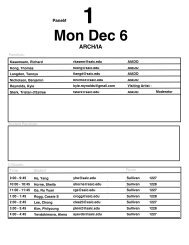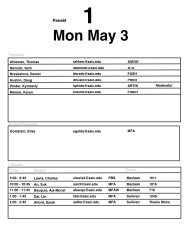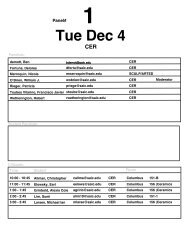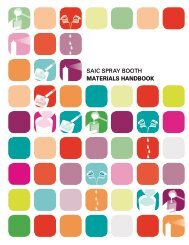i. institutional support and commitment to continuous improvement
i. institutional support and commitment to continuous improvement
i. institutional support and commitment to continuous improvement
You also want an ePaper? Increase the reach of your titles
YUMPU automatically turns print PDFs into web optimized ePapers that Google loves.
School of the Art Institute of Chicago<br />
Department of Architecture, Interior Architecture, <strong>and</strong> Designed Objects<br />
Master of Architecture<br />
Master of Architecture with emphasis in Interior Architecture<br />
program as it applied <strong>to</strong> Interior Architecture. Undergraduate classes in architecture <strong>and</strong> designed<br />
objects were instituted in the first phase of the Design Initiative <strong>and</strong> coincided with the department’s<br />
name change <strong>to</strong> the Department of Architecture, Interior Architecture, <strong>and</strong> Designed Objects (AIADO)<br />
<strong>to</strong> better reflect the range of disciplines embraced <strong>and</strong> their interactive orientation. Planning for new<br />
degree-specific courses of study began in earnest in 2003–04, <strong>and</strong> with its first summer boot camp in<br />
2006, the School welcomed the first incoming class of students in its new design programs, including<br />
the Master of Architecture, with its four tracks: professional <strong>and</strong> pre-professional, each with an optional<br />
emphasis in Interior Architecture, <strong>and</strong> the Master of Design in Designed Objects. The MArch program<br />
pursued National Architectural Accrediting Board certification, <strong>and</strong> in 2007, c<strong>and</strong>idacy was awarded<br />
after an initial report <strong>and</strong> site visit.<br />
In the initial Architectural Program Report (APR) of September 2006, AIADO reported planning for<br />
new facilities, new faculty <strong>and</strong> a re-structured <strong>and</strong> exp<strong>and</strong>ed administrative <strong>support</strong>. Nearly all of<br />
these plans have been completed, <strong>and</strong> computer <strong>and</strong> fabrication technologies have been updated.<br />
Successful searches in academic years 2006–07 <strong>and</strong> 2007–08 brought the number of full-time<br />
faculty in the department <strong>to</strong> 14. A full-time administrative assistant has been added <strong>to</strong> the staff of<br />
the administrative unit, <strong>and</strong> a re-structuring of faculty’s administrative duties has created a position,<br />
the Program Direc<strong>to</strong>r for MArch, <strong>to</strong> oversee the professional architecture program. New offices<br />
accommodating all full-time faculty were completed. In 2010, AIADO projects not-yet-completed but<br />
underway include the construction of a Material Resource Center, scheduled <strong>to</strong> open in Spring 2011.<br />
Curricular changes have been made in response <strong>to</strong> the last site visit’s Visiting Team Report (VTR),<br />
faculty assessment, <strong>and</strong> student feedback. The introduc<strong>to</strong>ry summer “boot camp” continues <strong>to</strong> shift<br />
its focus <strong>to</strong> technical skills, specifically computer application-based visualization <strong>and</strong> fabrication in<br />
response <strong>to</strong> students’ interest in a greater foundational competence before their first architecture<br />
courses in the fall.<br />
I. INSTITUTIONAL SUPPORT AND COMMITMENT TO<br />
CONTINUOUS IMPROVEMENT<br />
I.1. IDENTITY AND SELF ASSESSMENT<br />
I.1.2. Learning Culture <strong>and</strong> Social Equity<br />
A) Learning culture<br />
The AIADO faculty take pride in their statement of studio culture ideals, adopted on July 10, 2006, that<br />
encapsulates the ambitious <strong>and</strong> nurturing atmosphere they endeavor <strong>to</strong> foster in the classroom:<br />
It is the policy of the Department of Architecture, Interior Architecture, <strong>and</strong> Designed Objects<br />
<strong>to</strong> encourage the fundamental value of innovation, respect for the particular approaches <strong>and</strong><br />
skills of others, <strong>and</strong> the open sharing of information, between <strong>and</strong> among the members of its<br />
faculty, student body, administration <strong>and</strong> staff. This policy reflects the intersdisciplinary reality <strong>and</strong><br />
strength of the School of the Art Institute of Chicago.<br />
This ethos is the basis of the AIADO studio culture described below.<br />
1) Overview<br />
The School has an established reputation for studio classes based on individualized attention, technical<br />
demonstrations, <strong>and</strong> individual <strong>and</strong> group critiques. This approach has been applauded for decades<br />
by its high ranking in graduate programs among art schools in the US News <strong>and</strong> World Report. SAIC’s<br />
Architecture Program Report | 10



